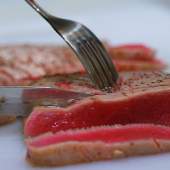Names Can Be Deceiving

The shocking news that Swedish meatballs actually originated in Turkey got us thinking: what other foods bear one name, but came from somewhere completely different (or are another thing entirely)? Here are some, but try not to hold it against them…
- French fries — America has been the grateful recipient of many significant things from the French — the Statue of Liberty, the bikini, and the sewing machine, to name just a few. But there is one famous item that is not among them: French fries. According to legend, they came about because some Belgian villagers in the late 17th century were faced with an exceptionally cold winter and a frozen-over river. Fishing was obviously not an option, so they had to come up with a quick alternative to the fried fresh fish that had been an important part of their diet. The answer was a fairly new arrival on the local culinary scene: potatoes. The villagers sliced them in a similar fashion to the fish and fried them. And a cheap, delicious dietary staple was born. Where did French fries get their name? American soldiers during World War I were served the sliced, fried potatoes while they were billeted with the Belgian army. Since their Belgian comrades mainly spoke French, the Americans dubbed the dish “French fries.” And they’ve been called that ever since, all over the world.
- German Chocolate Cake — In all fairness, this popular dessert, a light chocolate cake with coconut and pecan frosting, should rightly be known as “German’s Chocolate Cake” after inventor Samuel German, who invented a special form of mild dark baking chocolate back in 1852. “German’s Chocolate” didn’t make much of a splash on the market until 1957, when a Texas housewife, Mrs. George Calay, sent in a recipe to her local newspaper, the Dallas Morning-Star. On June 13 of that year, the paper chose Mrs. Calay’s “German’s Chocolate Cake” as their recipe of the day and ran it with some mouthwatering photos. Its popularity quickly spread (and German’s Chocolate sales skyrocketed); sometime after that, the apostrophe “s” was mistakenly dropped. Germany has been getting the credit ever since.
- Russian dressing — This once-popular salad dressing is not Russian at all, but thoroughly American in origin. James E. Colburn invented it in Nashua, New Hampshire sometime between 1910 and 1920, and it is thought that the “Russian” moniker came about because the recipe originally incorporated Russian caviar. Or because pickles or relish, supposedly beloved by Russians, are sometimes added to the ketchup-and-mayonnaise mixture. Or because it was ostensibly created for Salad Olivier, a hearty meat-and-potato salad that was popular in Moscow. Nobody is really sure, which might be why it has been mostly supplanted on restaurant menus by its blander cousin, Thousand Island dressing.
- Danish pastries — You would think that something called a “Danish” would be from Denmark, wouldn’t you? Well, guess again…the recipe for these flaky, buttery pastries, laden with fruit or cheese filling, was first brought to Denmark by Viennese bakers during a major wage strike in the 1850s. Their Danish counterparts eagerly latched on to the baking techniques of their Austrian colleagues, and local pastry fans responded by quickly snapping them up. They may be known everywhere else as “Danishes,” but the modest Danes, refusing to take credit, refer to them as “wienerbrød” (“Viennese bread”) in their own country. (By the way, that quintessentially French breakfast pastry, the croissant, originated in Austria as well. Sorry.)
- Spanish rice — This may sound confusing, but this is an American name for a Mexican side dish that is not Spanish at all. The explanation is fairly simple, though: rice was first introduced in Mexico during the Spanish invasion of the country that began in 1519; the conquistadors may have brought it with them from their travels in Asia. So, naturally, the dish became known as “Spanish rice.” These days, it’s more popular in America, especially as a side dish in Mexican restaurants.
- Dutch Baby — If you’ve ever run across this item on a menu at a pancake house or breakfast spot, you probably assumed that it was created in Holland, right? Nope. This baked popover that sometimes incorporates apples (thereby named the Apple Baby) was dreamed up in the early 20th century at a family restaurant in Seattle, inspired by the German Pfannkuchen. Reputedly, its “Dutch” name may have come from the proprietor’s daughter, who mispronounced “deutsch.”
If it’s true, as Shakespeare said, that “a rose by any other name would smell as sweet,” it’s also likely true that a food by any other name tastes just as good. So pay no attention to what they’re called. Just enjoy them!





